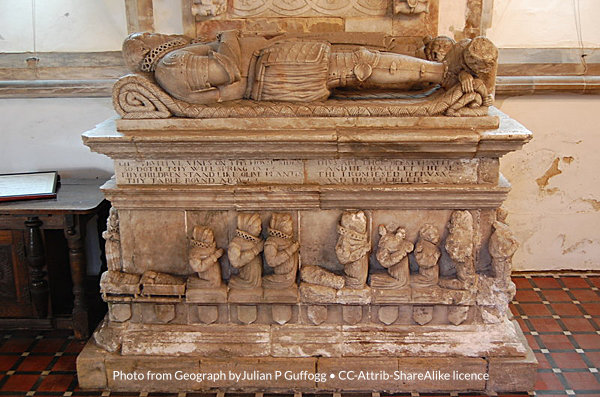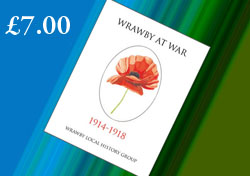Wrawby Local History Group
Lying 1½ miles north east of Brigg in North Lincolnshire, the ancient village of Wrawby is known to have been the site of a settlement from as early as Roman times. It derives its current name, however, from the time of the Danelaw when it was known as Wraghebi, or Wraghi's farm. The Domesday Book tells us that the village comprised a church with a priest and farming land, meadow land and woodland at the time of the Norman Conquest. Wrawby's roots were firmly in the soil then as now, although in recent years farm buildings and farmland have been sold to provide new homes.
The oldest surviving building in the village is the church of St Mary, which is probably Saxon in origin. The current structure has a 13th century tower and pillars. The font is 14th century with a carved Jacobean cover. There is an altar tomb of the Tyrwhitt family, lords of the manor until the mid 17th century (a role subsequently assumed by the Elwes family). A tapestry of "Christ blessing little children" hangs in the church. Its manufacturer, Thomas Tapling of London, who was born in the village, donated it. He also endowed the Parish Reading Room (now demolished), hoping to provide all the villagers the opportunity of an education. The graveyard surrounding the church was closed in 1857 when a new cemetery was opened on a larger site on the outskirts of Brigg, but there are still a number of fine headstones in situ for the family historian to view. The original vicarage house was burnt down in 1713, when all the parish records were lost. The oldest register in existence dates from 1675. A new vicarage was built in 1839; this was demolished in the 1960s.
Wrawby church originally also served the township of Brigg until a new church was built there in 1872. There were additionally in the village an Independent Chapel (built 1802), a Wesleyan Chapel (built 1827) and a Temperance Hall (built 1849). A new Methodist Chapel was built in 1895 and served the village for over a century, finally closing in 2005.
Major landowners into the 20th century included the Elwes family, Clare College Cambridge and the Earl of Yarborough. Land in Wrawby, with the advowson (right to appoint a vicar) was granted to Clare Hall, as it was then known, by Elizabeth de Burgo in 1348. The Tyrwhitts held the lordship from medieval times, and Robert Tyrwhitt is believed to have entertained Henry VIII lavishly at Wrawby (Kettleby manor house) in 1542.

Tomb of Sir Robert Tyrwhitt and his wife in Bigby Church, surrounded by their 22 children.
At the north eastern boundary of Wrawby parish with Melton Ross is the site of an old gallows, reputedly placed there on the order of King James as a warning to prevent bloodshed between the feuding Ross and Tyrwhitt families.
A major change in the agricultural scene came with the enclosure of Wrawby's open field and commons in 1800-1805. The land was divided between 43 landlords, with Elwes the principal owner. The Elwes estate in Wrawby was sold in 1919.
Although education had been provided for some of the Wrawby boys from the foundation of an old grammar school (now within the town of Brigg) in Tudor times, education for all the children of the village was not readily available until the building of the National School in 1842, at a cost of £433. It was enlarged to accommodate the greater population of the village in 1895. The population had risen from 283 in 1801 to around 1400 in 1891. The school and master's house (now a private house) along with several other fine houses of the eighteenth century built of the distinctive local brick remain. The local brick kilns on the outskirts of the village were finally demolished in the 1960s.
Standing as it does on a small hill, Wrawby is distinctive for its windmill, clear against the skyline on the approach to Brigg along the A18. The earliest record of a mill in Wrawby is 1585; in the nineteenth century there are known to have been two. The remaining mill, restored to a working condition in the 1960s, is Lincolnshire's last surviving post mill.
See the next column for details of History Group publications and how to purchase them.
The Wrawby Local History Group has published several books about Wrawby.
The first, "The Village on the Hill: a glimpse of Victorian Wrawby" contains chapters on farming, housing, education, the church and the mills in the village.
Its second book, "Wrawby At War 1914-1918" (above) tells the story of the inhabitants of the village during the Great War as reported in local newspapers. It is a tribute to those who fought and died in the War and it also records those left at home supporting the War effort and the effect it had upon them.
Both books is available direct from the Group - see below - also from the Tourist Information Centre in Brigg and the Black Horse pub in Wrawby. Cost of each book is £7.00. Please contact the group through Kay Rothery, The Secretary, Wrawby Local History Group, Priory Garth, Brigg Road, Wrawby, DN20 8RH, phone 01652 653315.
